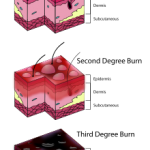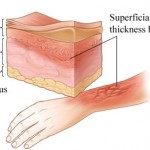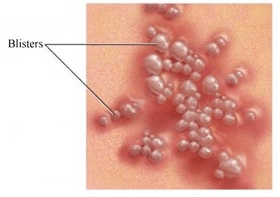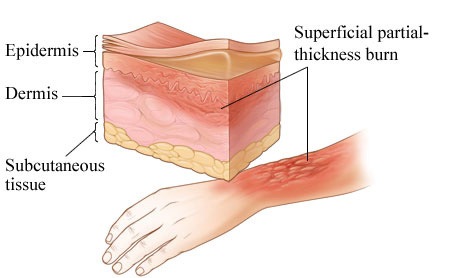First degree and second degree sunburns can occur when you are exposed to the sun’s UV rays. This usually happens if you don’t apply any sunscreen to your body or you might not have put enough on. It’s always a good idea to try and prevent sunburns before they even happen as that is the easiest way to keep your skin safe.
 Unless you are a hermit, it’s impossible to not be exposed to the sun. Most people are prepared when going outside, but there are times when the sun suddenly comes out and you can’t help it. Even when there are clouds in the sky you can still get sunburned.
Unless you are a hermit, it’s impossible to not be exposed to the sun. Most people are prepared when going outside, but there are times when the sun suddenly comes out and you can’t help it. Even when there are clouds in the sky you can still get sunburned.
Certain individuals who are more vulnerable to the sun’s rays include people with fair complexion, anyone that has a lot of freckles, red haired individuals and people with lighter color eyes. Those people probably already know that they are more prone to getting sunburns and it is a good idea for them to apply a higher SPF or sun proof factor with a value of 30 or higher. If you don’t put on any sun protection at all, your skin can burn within minutes.
Why Do You Need to Suffer Through Second Degree Sunburn?
Many people throughout their lifetime have been exposed to the sun for a little too long and develop first degree sunburns. When this happens, your skin gets irritated and starts to redden. The pain and redness may not show up for a few hours, but fortunately the symptoms for this type of burn will go away within a couple of days.
 Unfortunately, those who are exposed to second degree sunburns are not quite as lucky. It is very harmful for your skin and can cause long-term damage. The damage caused can show up almost right away and includes the following symptoms:
Unfortunately, those who are exposed to second degree sunburns are not quite as lucky. It is very harmful for your skin and can cause long-term damage. The damage caused can show up almost right away and includes the following symptoms:
- Extreme redness of the skin
- Warmness permeating from the surface of the skin
- Severe sting if anything touches your skin
- Blisters that may ooze out thick fluids
- Swelling might occur around the skin where the sunburn occurred
- Peeling of the skin when the sunburn starts to heal
This type of sunburn is also called “particle thickness†damage and is especially painful because the damage has reached your nerve endings under your skin. In some extreme cases of second degree sunburns, the person might experience symptoms such as a fever, wanting to vomit, dehydration, and a secondary infection. If you develop this type of burn, try not to contact the skin too much with any materials. This is especially important if you have blisters because they can pop very easily and you need to make sure to wash out the area when that happens. Otherwise you can develop more problems than just the sunburn. Some people who experience second degree sunburn might need to visit the hospital to help with the pain. If you are dehydrated you should also go to the hospital so they can put fluids in your system.
How to Treat Second Degree Sunburn Yourself
 Most people after being burned will not need to go to the hospital. There are things that you can do to help with the pain, but you just have to wait till it goes away. Make sure you cool the skin where the burn occurred. You can do this with a cool bath or shower. Never put the skin under cold water as this can cause more damage and it will probably hurt a lot as well. Local drug stores do offer soothing products to ease the pain. Calamine lotion is popular and used with second degree sunburns. If your skin is broken or have blisters, do not apply lotion there. Be sure to drink a good amount of water to rehydrate yourself. Try to take anti-inflammatory without steroids in it to help with the pain. Check with your doctor if you are unsure about which one to take. As I said earlier, never break open a blister. It will go away by itself by letting fluids ooze out slowly and the skin will heal itself over a period of time.
Most people after being burned will not need to go to the hospital. There are things that you can do to help with the pain, but you just have to wait till it goes away. Make sure you cool the skin where the burn occurred. You can do this with a cool bath or shower. Never put the skin under cold water as this can cause more damage and it will probably hurt a lot as well. Local drug stores do offer soothing products to ease the pain. Calamine lotion is popular and used with second degree sunburns. If your skin is broken or have blisters, do not apply lotion there. Be sure to drink a good amount of water to rehydrate yourself. Try to take anti-inflammatory without steroids in it to help with the pain. Check with your doctor if you are unsure about which one to take. As I said earlier, never break open a blister. It will go away by itself by letting fluids ooze out slowly and the skin will heal itself over a period of time.
Best Way to Avoid Getting Second Degree Sunburn
The best thing you can do to not be exposed to second degree sunburn is to avoid the sun altogether. You can take precautions easily when going out in the sun. I don’t think that getting a tan is worth the pain you might have to endure.
Make sure you choose the right level of SPF protection for your skin complexion. Anyone that has a fair complexion or freckles needs to use the highest SPF lotion you can buy. Only those people from the Mediterranean or have darker skin can use the lowest sun protection. Be sure to reapply the sun lotion every couple of hours unless you go swimming or sweat a lot.
Be aware that prolonged exposure to sun rays can also develop skin cancer. This should be a warning to those who have fairer skin and don’t protect themselves from the UV rays.
